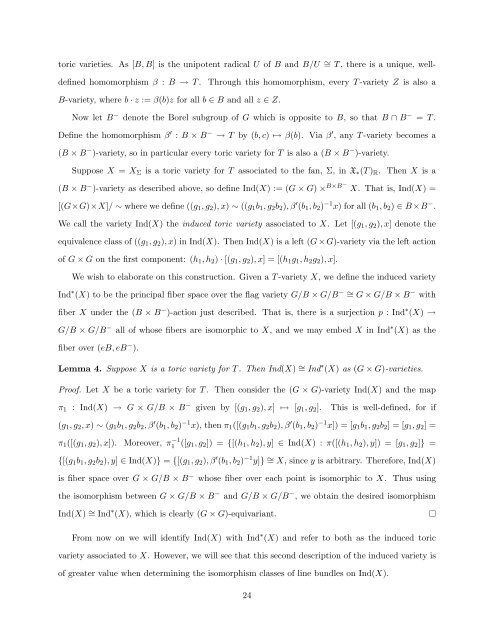Equivariant Embeddings of Algebraic Groups
Equivariant Embeddings of Algebraic Groups
Equivariant Embeddings of Algebraic Groups
Create successful ePaper yourself
Turn your PDF publications into a flip-book with our unique Google optimized e-Paper software.
toric varieties. As [B, B] is the unipotent radical U <strong>of</strong> B and B/U ∼ = T , there is a unique, welldefined<br />
homomorphism β : B → T .<br />
Through this homomorphism, every T -variety Z is also a<br />
B-variety, where b · z := β(b)z for all b ∈ B and all z ∈ Z.<br />
Now let B − denote the Borel subgroup <strong>of</strong> G which is opposite to B, so that B ∩ B − = T .<br />
Define the homomorphism β ′ : B × B − → T by (b, c) ↦→ β(b). Via β ′ , any T -variety becomes a<br />
(B × B − )-variety, so in particular every toric variety for T is also a (B × B − )-variety.<br />
Suppose X = X Σ is a toric variety for T associated to the fan, Σ, in X ∗ (T ) R . Then X is a<br />
(B × B − )-variety as described above, so define Ind(X) := (G × G) × B×B− X. That is, Ind(X) =<br />
[(G×G)×X]/ ∼ where we define ((g 1 , g 2 ), x) ∼ ((g 1 b 1 , g 2 b 2 ), β ′ (b 1 , b 2 ) −1 x) for all (b 1 , b 2 ) ∈ B ×B − .<br />
We call the variety Ind(X) the induced toric variety associated to X. Let [(g 1 , g 2 ), x] denote the<br />
equivalence class <strong>of</strong> ((g 1 , g 2 ), x) in Ind(X). Then Ind(X) is a left (G × G)-variety via the left action<br />
<strong>of</strong> G × G on the first component: (h 1 , h 2 ) · [(g 1 , g 2 ), x] = [(h 1 g 1 , h 2 g 2 ), x].<br />
We wish to elaborate on this construction. Given a T -variety X, we define the induced variety<br />
Ind ∗ (X) to be the principal fiber space over the flag variety G/B × G/B − ∼ = G × G/B × B − with<br />
fiber X under the (B × B − )-action just described. That is, there is a surjection p : Ind ∗ (X) →<br />
G/B × G/B − all <strong>of</strong> whose fibers are isomorphic to X, and we may embed X in Ind ∗ (X) as the<br />
fiber over (eB, eB − ).<br />
Lemma 4. Suppose X is a toric variety for T . Then Ind(X) ∼ = Ind ∗ (X) as (G × G)-varieties.<br />
Pro<strong>of</strong>. Let X be a toric variety for T . Then consider the (G × G)-variety Ind(X) and the map<br />
π 1 : Ind(X) → G × G/B × B − given by [(g 1 , g 2 ), x] ↦→ [g 1 , g 2 ]. This is well-defined, for if<br />
(g 1 , g 2 , x) ∼ (g 1 b 1 , g 2 b 2 , β ′ (b 1 , b 2 ) −1 x), then π 1 ([(g 1 b 1 , g 2 b 2 ), β ′ (b 1 , b 2 ) −1 x]) = [g 1 b 1 , g 2 b 2 ] = [g 1 , g 2 ] =<br />
π 1 ([(g 1 , g 2 ), x]).<br />
Moreover, π −1<br />
1 ([g 1, g 2 ]) = {[(h 1 , h 2 ), y] ∈ Ind(X) : π([(h 1 , h 2 ), y]) = [g 1 , g 2 ]} =<br />
{[(g 1 b 1 , g 2 b 2 ), y] ∈ Ind(X)} = {[(g 1 , g 2 ), β ′ (b 1 , b 2 ) −1 y]} ∼ = X, since y is arbitrary. Therefore, Ind(X)<br />
is fiber space over G × G/B × B − whose fiber over each point is isomorphic to X. Thus using<br />
the isomorphism between G × G/B × B − and G/B × G/B − , we obtain the desired isomorphism<br />
Ind(X) ∼ = Ind ∗ (X), which is clearly (G × G)-equivariant.<br />
From now on we will identify Ind(X) with Ind ∗ (X) and refer to both as the induced toric<br />
variety associated to X. However, we will see that this second description <strong>of</strong> the induced variety is<br />
<strong>of</strong> greater value when determining the isomorphism classes <strong>of</strong> line bundles on Ind(X).<br />
24
















